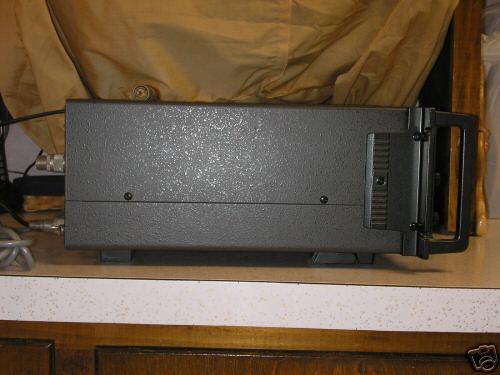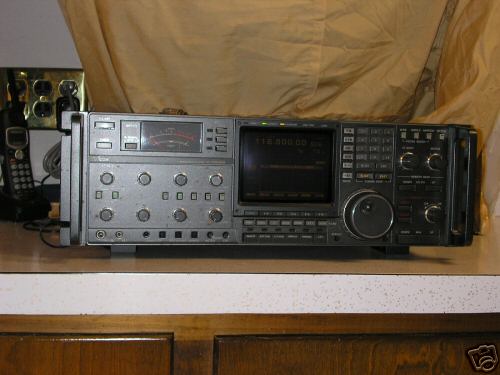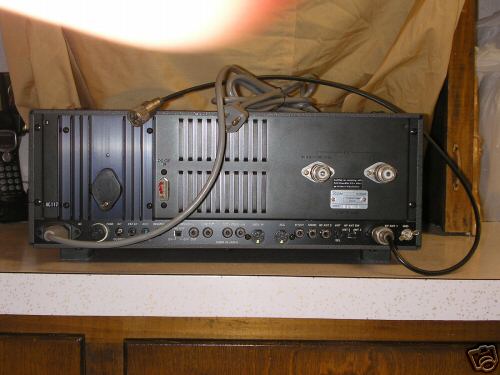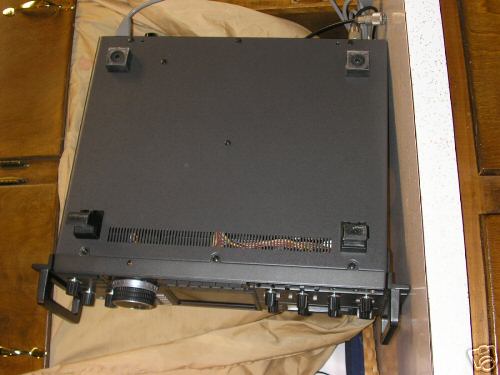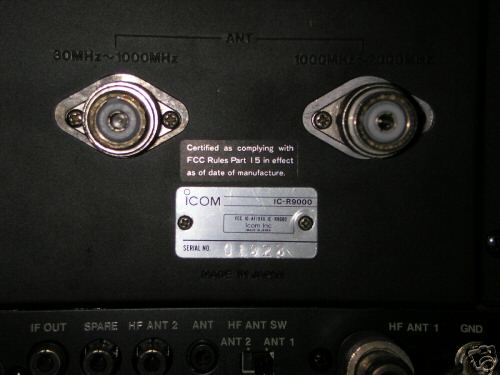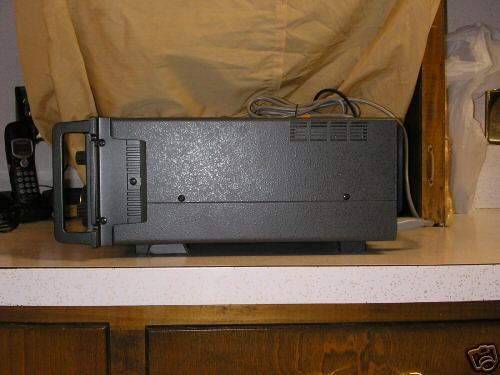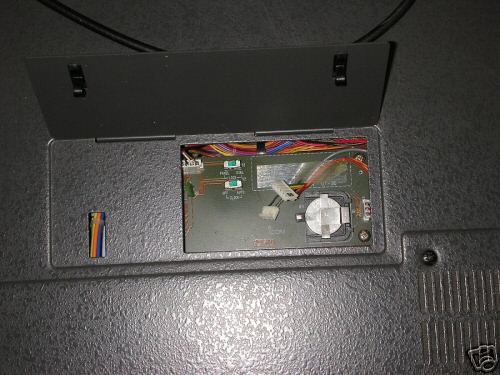|
The Cadillac of all receivers, the Icom IC-R9000. I am offering this as a middle-man for the original owners widow. Please feel free to ask me any questions, but i may be a day or so replying, if i don't know the answer. I took decent pictures, but the radio is not in my possession, so adding additional ones will take at least 24 hours. I will, however be able to get more, if needed, just please ask early. I forgot to mention that this radio is in mint, "like new" condition. It was never stored or used outside, or in the garage, and always protected with a cloth dust cover when not in use. Here is a bit more information for you from: http://www.radionetherlands.nl/features/media/productreviews/receivers/icr9000.html Year Introduced: 1985 Power: Mains, 12 V DC supply optional Size: 424 x 150 x 365 mm Weight: 20 kg Price: US$6200 (see note below), CAN$9000, A$8500 Coverage: 0.1 - 1999.8 MHz continuous Note there are regional variations of this receiver. Further, in the USA the IC-R9000 is no longer sold to the public due to laws that now prohibit monitoring cellular telephone calls. USA government agencies may still purchase the receiver. At first glance, the ICOM ham radio transceiver called the IC-781 looks very similar to the R9000. The IC-781 been around much longer, but our tests show the R9000 is not just the 781 without the transmitter section. The focal point of the receiver is an orange coloured cathode ray tube. When you first switch on it shows the frequency the radio is tuned to, within a resolution of 10 Hz, and the tuning step that has been selected on the main rotary tuning knob. You can jump up the dial in 100 kHz steps at a time, or select any one of 8 other tuning steps down to the very fine 10 Hz increments. Icom uses the screen to simplify access to radios 1000 memory channels, its video-recorder style timer, and its extensive scanning system. Menu information on the screen gives you options, and you select them using the 6 function keys just underneath. Whilst the menus on the screen are simple to use, the keyboard on the set is poorly designed. We asked several people to try it out, and most complained that because the keys are small and close together its easy to punch in a wrong number. No one uses a calculator by standing up vertically and trying to punch in numbers. Likewise, the R9000 would be easier to operate if a separate accessory was available so you could tap in the numbers on a horizontal keypad. The keyboard software is rather user unfriendly too. Tuning is greatly enhanced by a spectrum analyser on the front panel. If you select this then you get a visual representation of 25 kHz either side of the frequency you are tuning. Transmitters are shown as a sharp peak. In a crowded broadcast band like 49 metres you get something that looks a mountain range that is constantly moving up and down as propagation affects the incoming signals. The resolution turns out to be adequate to spot weak signals next to strong ones. You simply twist the dial to hear what the small blip on the screen is actually saying. On higher frequencies you can widen the "window", otherwise the blips on the screen are too far apart. If you are someone who likes to bandscan, this device is brilliant, even more so because it remains activated while the radio is in the scanning mode. 1000 memories might seem too much for a shortwave listener. But on higher frequencies where signals are more spread out, logging marker stations is very useful. The radio can be controlled by a home computer if an optional interface is connected. There is suitable software on the market for you to set up very complex scanning procedure's if you want to. There's an option for a built in voice synthesizer to which you can use to announce frequencies on one channel of a stereo tape recorder, while the audio is registered on the other. The voice announces in English or Japanese. The radio has a video output, so by connecting a computer monitor you can start searching for television signals. This review was compiled independently. Radio Netherlands has no financial connection with ICOM, the manufacturer of this receiver. Introduction For most of us, the R9000 will remain out of reach, even in the second hand market. Nevertheless, judging from reader response, there is a strong interest in how well it performs. At first glance, an ICOM ham radio transceiver called the IC-781 looks very similar to the R9000. The IC-781 has been around much longer, but our tests showed the R9000 is not just the 781 without the transmitter section. Most versions of the Icom IC-R9000 cover from 100 kilohertz, continuously through long, medium, and shortwave, VHF and UHF frequencies until coverage stops at 1999.8 MHz. The French version does not include the FM broadcast band between 88 and 108 MHz to avoid a certain import duty. In Holland, though, the full coverage version is available, and that is what we tested. The focal point of the receiver is an orange-coloured cathode ray tube. When you first switch on it shows the frequency the radio is tuned to, within a resolution of 10 Hz, and the tuning step that has been selected on the main rotary tuning knob. You can jump up the dial in 100 kHz steps at a time, or select any one of 8 other tuning steps down to the very fine 10 Hz increments. ICOM uses the screen to simplify access to the radio's 1000 memory channels, its video-recorder style timer, and its extensive scanning system. Menu information on the screen gives you options, and you select them using the 6 function keys just underneath. Televisions and computer monitors are generally regarded as one of radios ardent enemies. Just put a radio near a TV and all you will hear is a continuous buzz. ICOM has therefore done a lot of screening to ensure the monitor inside this radio is doesn't radiate radio frequency noise. Indeed you can put a portable on top of the radio and not suffer any interference. There is some unavoidable radiation from the front of the display though, and that is not removed when the screen is put into a standby mode. Whilst the menus on the screen are simple to use, the keyboard on the set is poorly designed. We asked several people to try it out, and most complained that because the keys are small and close together its easy to punch in a wrong number. Nobody uses a calculator by standing up vertically and trying to punch in numbers. Likewise, the R9000 would be easier to operate if a separate accessory were available so you could tap in the numbers on a horizontal keypad. The keyboard software is rather user unfriendly too. Instead of making a separate kilohertz and Megahertz button as other companies have done on cheap portables. So on medium wave for instance, you cannot just punch in 747 kHz. You have you put in 0.747 MHz. That takes some getting use to, especially if you want to jump from one part of the dial to another quickly. http://www.radionetherlands.nl/assets/images/icomtab.jpg The four selectivity options switch in sharp or wide filters which offer good shape factors, enabling you to pick out signals you want. Tuning is greatly enhanced by a spectrum analyser on the front panel. If you select this then you get a visual representation of 25 kHz either side of the frequency you are tuning. Transmitters are shown as a sharp peak. In a crowded broadcast band like 49 metres you get something that looks a mountain range that is constantly moving up and down as propagation affects the incoming signals. The resolution turns out to be adequate to spot weak signals next to strong ones. You simply twist the dial to hear what the small blip on the screen is actually saying. On higher frequencies you can widen the "window", otherwise the blips on the screen are too far apart. If you are someone who likes to bandscan, this device is brilliant, even more so because it remains activated while the radio is in the scanning mode. 1000 memories might seem too much for a shortwave listener. But on higher frequencies where signals are more spread out, logging marker stations is very useful. The radio can be controlled by a home computer if an optional interface is connected. There is suitable software on the market for you to set up very complex scanning procedure's if you want to. There's an option for a built in voice synthesizer to which you can use to announce frequencies on one channel of a stereo tape recorder, while the audio is registered on the other. The voice announces in English or Japanese. The radio has a video output, so by connecting a computer monitor you can start searching for television signals. If you have an external radio teletype or packet converter, the text can also be fed back into the R9000 so press agency copy appears on the screen, although the text might be rather small for some older people. Ventilation of the radio is important, the back panel gets rather warm within half an hour of continuous use. As it weighs 20 kilos, it is not a good idea to carry the R9000 very far. Reviewers: Jonathan Marks, Diana Janssen, & Willem Bos. (please look at our rules and privacy policy) |
A.Hewitt@machine--tools.com (Alisa Hewitt) for additional information. This email is used for forwarding to newsgroup user.
